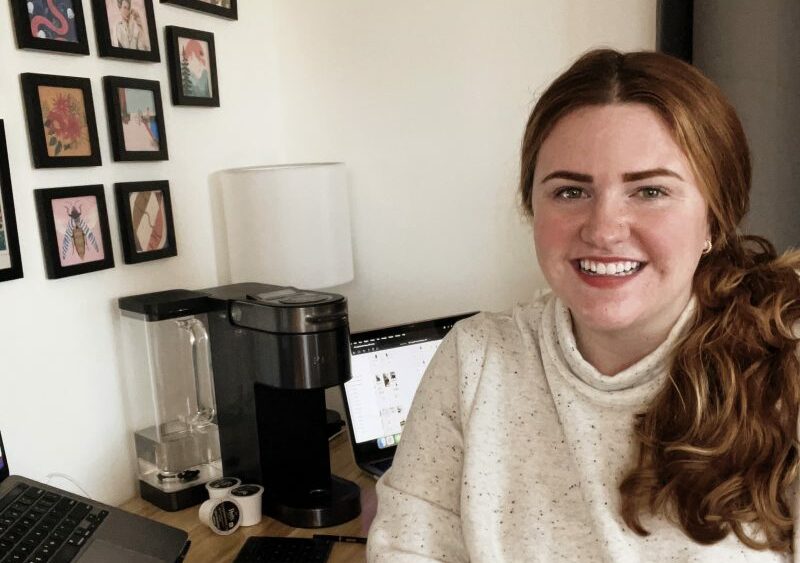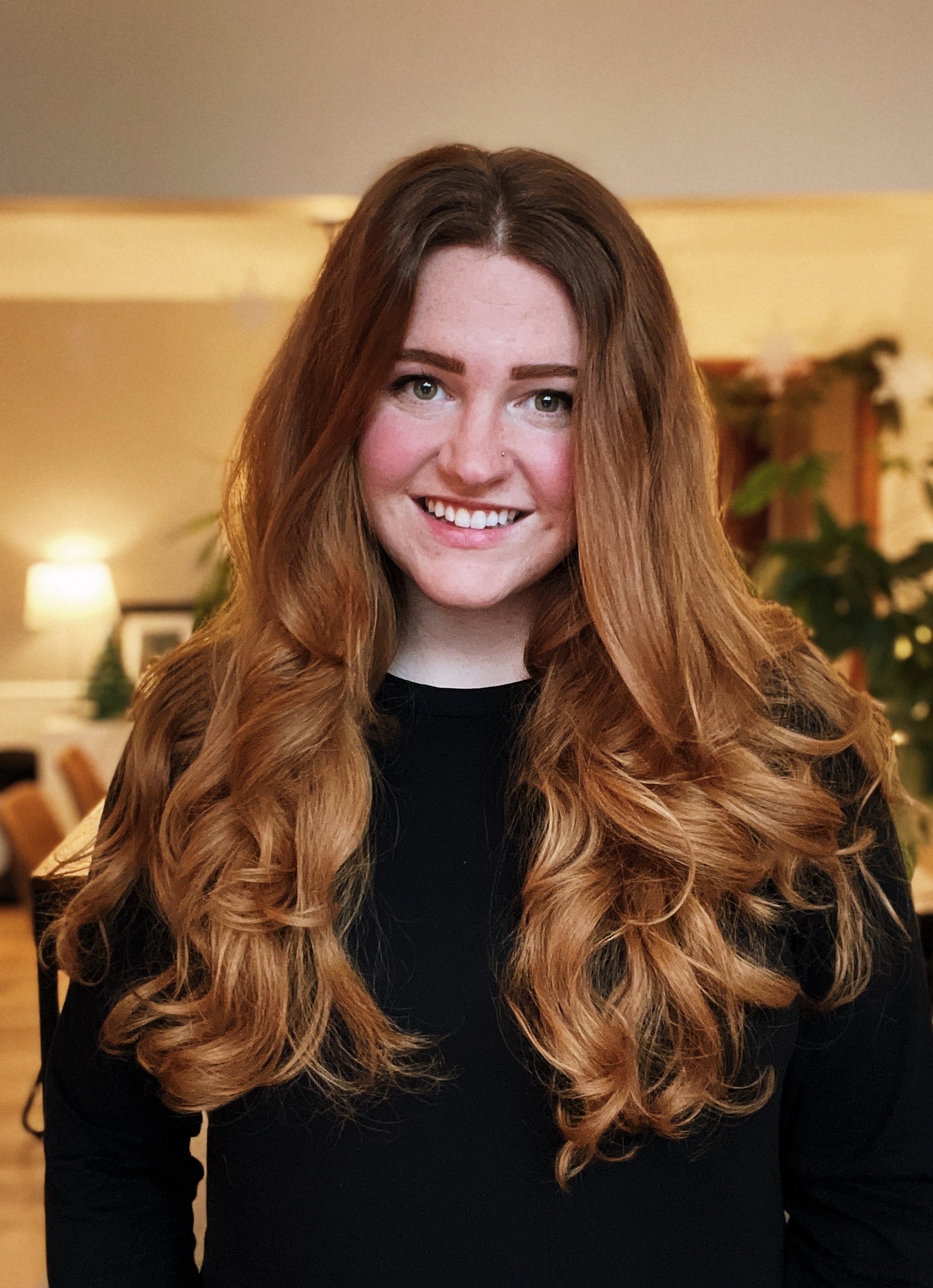Springboard Mentor Spotlight: Meg Clayton

Meet Meg Clayton, senior UX designer at Keurig Dr. Pepper and a mentor for Springboard’s UI/UX and UX Design Career Tracks.
As a UX designer specializing in smart home consumer products, Meg Clayton occupies a unique niche in design. While UX design is normally associated with web or mobile interfaces, designers play a key role in designing experiences for internet-connected appliances, also known as IoT (Internet of Things) devices, such as smart speakers and smart home security systems. This calls for special skills like conversation design, an understanding of the omnichannel customer experience, and knowledge of how consumers interact with hardware.
Prior to her current role, Clayton worked at Whirlpool Corporation for nearly seven years, where she and her husband were both UX designers on the same team. She decided to become a mentor at Springboard after she saw how much her husband enjoyed mentoring. Recently, Clayton joined the Mentor Advisory Board at Springboard because she is passionate about the Springboard community and contributing to the mentoring experience, something many students cite as their top reason for choosing Springboard.
Clayton says the best part about being a mentor is it leaves no room for complacency, since she has to keep her skills up to date. Also, seeing people discover their passion for design reminds her why she got into the field in the first place.
“I’m constantly learning from my students. Everyone has such a diverse background,” said Clayton. “I’ve had people from finance backgrounds to forensic science—things that are definitely not design-related. Seeing them go from the point where they’re curious about design to the point where they’re passionate about it is just so magical for me as a mentor.”
Tell me about your current role at Keurig Dr Pepper. What types of problems are you working on?
I’ve been with Keurig for about six months and I joined specifically to work in the IoT space. Basically, I work with connected small brewers—anything that can be controlled with a mobile app and has smart capabilities.
In the connected coffee space, we’re trying to make people’s days easier, more efficient and really cater to the individual user—anything to reduce some of the heavy lifting and bring joy to their day. Sometimes coffee is like a ritual for people, so we really want to make that experience a positive one, especially given that so many people are working from home now.
What are some things an IoT-powered coffee brewer can do that a regular coffee brewer can’t?
That’s a great question. The little coffee pods have barcodes on them so the brewers can actually recognize those pods and we can recommend similar varieties. There are automated subscriptions so that if your brewer detects you’ve brewed 30 pods and you’re running low, then it’ll reorder automatically so you’re never out of coffee. It also caters seasonal recommendations to your tastes and preferences and it can also help with maintenance. For example, sending you reminders to change your water filter.
Get To Know Other Design Students
Heidi Sanders
Sr. Digital Designer at Kendo Brands
Reyna Martinez
Associate UX Designer at ServiceMax
Aisha Butt
UX Associate at Meta
When people think of UX design, they usually think of web or mobile interfaces, not IoT. Can you talk a little bit about the role of a UX designer when it comes to IoT devices?
Early on in my career, IoT was not a direction I expected to take. I found myself in the physical product design space working on embedded interfaces and realized pretty quickly that the fundamentals of UX and UI also apply to IoT; it’s just a different set of constraints. When dealing with IoT, it’s never just one touchpoint.
When I’m designing an experience for IoT, I’m looking at a physical product interface, a mobile app, a web experience, and potentially even a Google Home or Amazon Alexa experience that goes with it. So, there are all these different user touchpoints that come together.
Are there any specific disciplines or specializations within UX you need to know in order to work on IoT, such as conversation design or UX writing?
I think what helps the most in this career path is just a really deep understanding of technology and what’s available on the market. Things shift all the time—there are new smartphones, new hardware. Google Home and Amazon Alexa are constantly being updated. Knowing the technology that people have and how they use it really makes a difference when you’re designing for that kind of daily interaction within the home.
So it’s not like we want to design some science fiction scenario where everything is robots and magic. It’s still very realistic and tangible. Also, it’s not just about home appliances. How are automotive interfaces changing? We’ve seen a shift from very analog controls to digital interfaces and even voice-activated interfaces in cars.

The technology might sound intimidating at first, but at the end of the day it comes down to understanding the user.
Yes, understanding the user and understanding technologies.
Let’s talk a little bit about your experience as a mentor at Springboard. What would you say is the most rewarding thing about being a mentor?
It’s definitely two things for me. One is I’m constantly learning from my students. Everyone has such a diverse background. I’ve had people from finance backgrounds to forensic science—things that are definitely not design-related. Seeing them go from the point where they’re curious about design to the point where they’re passionate about it is just so magical for me as a mentor.
The second thing is that seeing people become passionate about design always rekindles my own love for design. It inspires me to be better and stay up-to-date on everything. There’s not a lot of room for complacency, so mentoring is a way that I can push myself to also be constantly improving as well so I can be there for my students.
What is something you have learned from your mentees? Can you give an example?
I worked with a student who was a project manager. He was very motivated by the fact that he wanted a better way to communicate with designers on his team. Working with him gave me such a different perspective on the business side of product management and how to approach business challenges from a holistic perspective.
We really challenged each other. I think it was very symbiotic, because I was asking him why he would consider things from a certain angle, and he was very business-oriented but also user-focused. So he really taught me a lot about business acumen and things of that nature, and I really appreciated that.
So he didn’t necessarily want to become a designer himself; he just wanted to be a better project manager.
Exactly. That was kind of a unique situation. I don’t see a lot of that, but I loved that he was so passionate about it.
What is the most interesting project you’ve worked on in your career?
When I was at Whirlpool, my team and I were tasked with designing a digital experience that spanned every appliance category. We needed an interface that was consistent across a fridge, an oven, and a washing machine. On top of that, we needed to integrate this universal interface with the Google Home and Nest Thermostat experience.
Then there was also the Whirlpool mobile app, for which I led the design and production. So there were a lot of pieces to it and it was meant to be a global platform sold in multiple regions throughout the world, which meant we had to accommodate over 30 different languages as well.
We had a lot of technical challenges, and we had to get research data from every single region we wanted to serve. For example, how people interact with their oven in North America versus in Italy or Brazil. It was a giant project but it was a lot of fun.
When you worked at Whirlpool, you and your husband Alex were both UX designers on the same team. What was it like working with your spouse?
It’s funny, we both started right out of school working together at Whirlpool. We had also gone to school together. Thankfully, everyone was cool with it and accepted it. People thought we wouldn’t be able to critique each other’s work, but I think it was kind of the opposite—we were a little too comfortable critiquing each other.
We were pretty brutally honest in some scenarios, but I think it made the work that much better. We had a lot of fun and we tackled a lot of different things. Now we’re at separate companies, but we have a baby now and that’s by far the most complicated project!
Do you think aspiring designers should specialize in a specific field like UX research or UI design? Why or why not?
For people who are new to the industry, it’s worth getting exposure to as many different areas as possible. Get exposure to UI and research, try to design for mobile and web. I think getting a breadth of experience is really helpful, because it opens doors down the road. It also helps you figure out what you like so you can land a job where you love coming to work every day.
How should a new designer prepare for their first design sprint? What are some of the challenges of working on a design sprint?
The most important thing is communication, honestly. Foundational design skills are only one part of the challenge. The rest is working with a cross-functional team. You need to be able to communicate with business partners, software developers—anyone that you’re collaborating with. It’s hard to practice something like that as a student, so be very sensitive about communicating and building that trust with your team.
What was your experience like working with your very first client?
I’ve always been an in-house designer; I have not done agency work where I’ve had external clients. But even being in-house, we have internal stakeholders, leadership teams, directors, VPs. They are our clients, essentially. Getting approval and alignment with a team comes down to knowing your audience, knowing how to communicate and presenting your work in a way that’s geared towards the user.
What overall advice do you have for new designers?
This is probably a cliché, but stay curious, stay motivated. Keep your passion for design as close to your heart as you can, because there’s always room for growth. Whether you’re a junior designer or you’re a chief design officer, having that curiosity and passion and desire to learn is something that will always benefit you no matter where you’re at.
Want to become a mentor? Apply here!
Since you’re here…
Are you a future UX designer? Enroll in our UI/UX Bootcamp and join over 10,000 students who have successfully changed careers with us. Want to get wireframing right this second? Check out our free UX learning path today.





